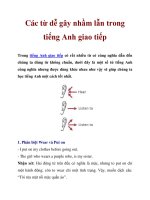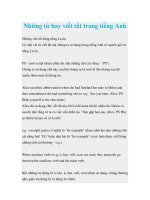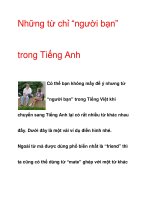Những từ dễ nhầm lẫn trong tiếng anh 3 pptx
Bạn đang xem bản rút gọn của tài liệu. Xem và tải ngay bản đầy đủ của tài liệu tại đây (174.33 KB, 6 trang )
ONTO
OR ON TO?
an
OFFICIAL
visit
an
OFFICIAL
invitation
OFFICIOUS
=
fussy,
self-important, interfering
an
OFFICIOUS
secretary
an
OFFICIOUS
waiter
often
(not
offen)
omission
omit
omitted, omitting
See
ADDING
ENDINGS
(iv).
one
This
can be a
useful
impersonal pronoun:
ONE
never knows.
However,
it can be
difficult
to
keep
up in a
long
sentence:
ONE
never knows
if
ONE'S
husband
is
likely
to
approve
of
ONE'S
choice
but
that
is a
risk
ONE has
to
take.
Use
'one'
sparingly
and
beware
the
risk
of
pomposity.
only
The
position
of
'only'
in a
sentence
is
crucial
to
meaning.
See
AMBIGUITY
(ii).
onnist
Wrong spelling.
See
HONEST.
onto
or on to?
There
are
circumstances when
the
words
must
always
be
written separately.
We
will
consider
these
first.
149
OPHTHALMOLOGIST
Always
write
the
words separately
if
'to'
is
part
of
an
infinitive
(e.g.
to
eat,
to
speak,
to be, to
watch,
etc.):
She
drove
ON TO
test
the
brakes.
As
a
matter
of
interest
you can
double-check
the
'separateness'
of the two
words
by
separating
them
further:
She
drove
ON
because
she
wanted
TO
test
the
brakes.
Always
write
the
words separately when
'to'
means
'towards':
We
cycled
ON TO
Oxford.
Once again,
the two
words
can be
further
separated:
We
cycled
ON the few
remaining miles
TO
Oxford.
It
is
permissible
to
write
'onto'
or
'on
to'
when
you
mean
'to
a
position
on':
The
acrobat jumped
ONTO
the
trapeze.
The
acrobat jumped
ON TO the
trapeze.
It
should
be
borne
in
mind, however, that many
careful
writers dislike
'onto'
and
always
use
'on
to'.
'Onto'
is
more common
in
American
English
but
with
the
cautions expressed above.
ophthalmologist
(not
opth-)
opinion
(not
oppinion)
opposite
oral
See
AURAL
OR
ORAL?.
150
OUT
OF
organise/organize
Both
spellings
are
correct.
original
originally
original
+
ly
ought
'Ought'
is
always followed
by an
infinitive
(to
visit,
to
read,
to do,
etc).
We
OUGHT
to
write
our
thank-you
letters.
The
negative
form
is
'ought
not'.
We
OUGHT
NOT to
hand
our
work
in
late.
The
forms
'didn't
ought'
and
'hadn't
ought'
are
always wrong.
He
didn't ought
to say
this.
He
OUGHT
NOT to say
this.
He
hadn't ought
to
have
hit
her.
He
OUGHT
NOT to
have
hit
her.
ours
There
are
eight possessive pronouns:
mine, thine, his, hers, its, ours, yours, theirs. They
never need
an
apostrophe:
This
house
is
OURS.
outfit
outfitted,
outfitting,
outfitter
(exception
to
2-1-1 rule).
See
ADDING ENDINGS (iv).
out
of
Avoid
using
'of
unnecessarily:
He
threw
it OUT OF the
window.
He
threw
it OUT the
window.
151
OUTRAGEOUS
outrageous
(not outragous)
See
SOFT
c
AND
SOFT
G.
over-
Take care when adding this
prefix
to a
word
already
beginning with
r You
will have
-rr-:
overreact
overripe
overrule,
etc.
overreact
over
+
react
ovum
(singular)
ova
(plural)
See
FOREIGN
PLURALS.
owing
to
See DUE
TO/OWING
TO.
152
packed
We
took
a
pack lunch with
us.
We
took
a
PACKED
lunch with
us.
paid
(exception
to the -y
rule;
not
payed)
See
ADDING ENDINGS
(iii).
paiment
Wrong spelling.
See
PAYMENT.
pajamas
American
spelling.
See
PYJAMAS.
palate,
palette,
pallet
PALATE
= the top
part
of the
inside
of
your mouth
PALETTE
= a
small board with
a
hole
for the
thumb
which
an
artist uses when mixing paints
PALLET
= a
platform used
to
lift
and to
carry
goods
panic
panicked, panicking, panicky
See
SOFT
c
AND
SOFT
G.
paparazzo
(singular) paparazzi (plural)
See
FOREIGN
PLURALS.
paraffin
paragraphing
There
is no
mystery about paragraphing although
many
students
find it
difficult
to
know when
to end
one
paragraph
and
begin another.
A
paragraph develops
a
particular
point
that
is
relevant
to the
overall
subject.
If you
wish
to
write
a
letter
or an
essay that develops
five or six
points,
then each point will have
its own
paragraph
and you
will
add two
more,
one by way of an
introductory
153
^•^H
PARAGRAPHING
paragraph
and
another
at the end as a
conclusion.
There
are no
rules about
how
long
a
paragraph
should
be.
Some paragraphs,
often
the
introduction
or the
conclusion,
may be a
single sentence; other
paragraphs
may be a
page
or
more long.
Too
many
short paragraphs
in
succession
can be
very
jerky;
too
many
very long ones
can
look forbidding.
It is
best
to mix
long
and
short paragraphs,
if you
can.
You
may
also
find
that
a
paragraph which
is
becoming very long
(a
page
or
more) will
benefit
from
being subdivided.
The
topic
of the
paragraph
may
be
more sensibly developed
as two or
three
subsidiary
points.
Clear
paragraphing
is not
possible without clear
thinking. Think
of
what
you
want
to say
before
you
begin
to
write.
List
the
topics
or
points
you
want
to
make
in a
sensible
order.
Then develop each
one in
turn
in a
separate paragraph.
A
paragraph
usually
contains within
it one
sentence which sums
up its
topic.
Sometimes
the
paragraph will begin
with
this sentence (called
a
topic sentence)
and the
rest
of the
paragraph will
elaborate
or
illustrate
the
point
made. Sometimes
the
topic sentence occurs during
the
paragraph.
It can be
effective,
from
time
to
time,
to
build
up to the
topic
sentence
as the
last sentence
in a
paragraph.
Careful
writers will
try to
move smoothly
from
one
paragraph
to the
next, using link words
or
phrases such
as: on the
other hand; however;
in
conclusion.
In
handwriting
and in
typing,
it is
usual
to
mark
the
beginning
of a
paragraph either
by
indenting
it
by
2cm or so, or by
leaving
a
clear line between
paragraphs.
The
only disadvantage
of the
latter
method
is
that
it is not
always clear, when
a
sentence begins
on a new
page, whether
a new
paragraph
is
also intended.
154









